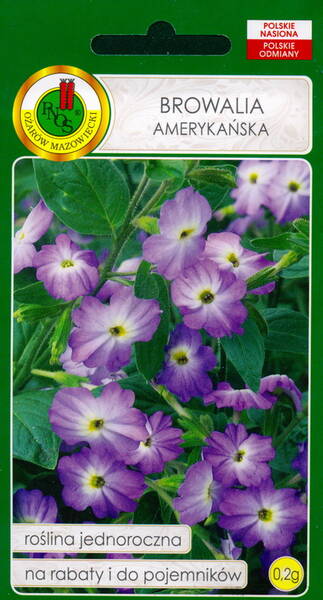This plant, in response to attention and care, will thank you with abundant and long flowering.
Forms a low, highly branched bush with flexible shoots, perfectly combines the colour of sky-blue flowers and dark green foliage. Well-formed.
The flowers are star-funnel-shaped, with a strong texture, up to 2-3 cm in diameter, axillary or collected in loose racemose inflorescences.
Browallia is unpretentious, quite cold-resistant, prefers sunny places protected from the wind with drained soil.
Grown in hanging baskets, garden containers, used for flower beds, borders, balconies.
Grows well indoors as a perennial. The optimum soil temperature for seed germination is +18+20°C.
* Browallia is an annual shrub plant with elegant tubular flowers. Browallia belongs to the nightshade family (Solanaceae), common in Central and South America.
Origin: Peru.
Name: in honour of the Swedish Bishop J. Brovall, a friend of Carl Linnaeus.
The plant is an annual, growing in the form of broadly branched bushes up to 50 cm tall. The flowers are blue or white, collected in loose, racemose inflorescences. In culture since 1829.
Location: when planted in a flower garden, plants can be located in bright sun, but containers and hanging baskets are best placed in light partial shade.
Watering should not be excessively plentiful, but the root ball should not be allowed to dry completely. If the plant wilts, it will be impossible to restore it.
Soil: Browallia prefers poor soil, but grows in almost any soil.
Reproduction: by sowing seeds in early April in greenhouses or in early May in a permanent place. Seedlings appear after two weeks at a temperature of +20°C.
Seedlings are pinched to encourage vigorous tillering. Seedlings are planted outdoors after the last spring frosts have passed.
The distance between plants is 20-30 cm. In 1 g there are up to 5000 seeds, the germination of which lasts up to 3 years.
Usage: for flower beds, borders, vases, as pot culture.
Browallia has a very unusual appearance, which is why it is often used to create informal free compositions.
Its flexible shoots, studded with flowers that look like flying blue-violet butterflies, hang spectacularly from the edges of containers, flower pots or hanging baskets.
Light spots located in the centre of the flowers give them additional sophistication.
Eng: Amethyst Flower, Browallia, Bush Violet, Jamaican Forget-Me-Not, Pensamientos De Pobre.
Bot. syn.: Browallia cordata, Browallia demissa L., Browallia dombeyana, Browallia elata L., Browallia grandiflora, Browallia lenetta, Browallia linnaeana, Browallia melanotricha, Browallia nervosa, Browallia peduncularis, Browallia viscosa auct. non Kunth, Nierembergia petunioides Dunal.
Flowering Season: Spring to fall.
Light Requirements: Partial shade to shade.
Flower Color: Purplish, blue, violet, white star-shaped flowers.
Height: 1 to 3 feet.
Spacing: 6 to 8 inches.
Prefers rich, well drained soil; keep evenly moist; spread of 3 feet; round habit; over watering or over fertilizing will promote foliage at the expense of flowers
Cultivars: Major (dark blue), Blue Bells (violet blue).
Potting of browallia.
Browallias are usually grown as annuals and are raised from seeds or cuttings in March. In the middle of May, they can be planted outside in full sun, 9 inches apart. They can also be planted in 5-inch pots, filled with equal parts of loam and leaf mold with a bit of sand added, to bloom in the greenhouse or window garden. When the flower buds show, those in pots should be watered with dilute liquid fertilizer weekly.
Propagation of browallia.
Cuttings, made from the current year s shoots, are taken in September or March and inserted in a propagating case in a warm greenhouse. Seeds can be sown in March in a greenhouse that has a 50- to 55-degree temperature. Plant them in pots of fine, sandy soil and lightly cover them. When they re an inch or so high, they re potted individually in small pots filled with the compost described in potting, or they can be set 2 to 3 inches apart in flats filled with similar soil. Keep them in a greenhouse or cold frame until mid-May, when they may be planted outside in full sun, 9 inches apart. Seeds that are sown in June will bloom during the winter in a greenhouse that has a 45- to 50-degree temperature.















